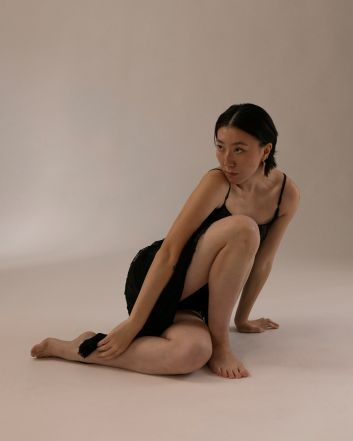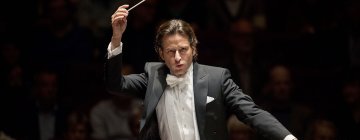My neighbor has a series of signs on their fence with the simple slogan “We Are Not Okay,” written underneath images of American flags. Each time I drive or walk past the signs, it gives me pause. Because, well, we are not okay.
Inevitably, this leads an artist/ art appreciator to ask questions: How do we tap into a creative impulse when our senses are inundated by suffering, both our own and that of others? How do we make art when we are not okay?
The contributors to Saturday evening’s performance at ODC’s State of Play Festival provided some possible responses to these questions. Curated under the umbrella of a spirit of play, the lineup involved one “Experimenter” (or work-in-progress) showing by NYC-based Kimie Parker; two “Curious Creators,” Leila Awadallah and Black Benatar, who each performed half-hour offerings in various stages of development; and one “Risk Taker” performance, an hour-long piece by NYC-based duo Lisa Fagan and Lena Engelstein. When experienced in light of current events — from genocide against the Palestinians and attacks on reproductive, immigrant, and LGBTQ+ rights to the rise of authoritarianism — these performances represent bold responses to what some characterize as democracy under siege.
The most direct responses to these crises could be seen in the half-hour-long offerings of Awadallah and Black Benatar. Black Benatar put the “cistem” on trial with an imaginative retelling of her struggles as a Black queer woman in a corrupt health-care system. Playing the roles of attorney, judge, and witnesses — which happened to be her own ovaries and cysts — Black Benatar used puppetry and costume to reclaim agency after having been ignored and belittled by doctors as she moved through chronic pain and infertility. The concept is promising, but still unrealized in performance — Black Benatar read from scripts on music stands and struggled a bit with lengthy costume changes.
Awadallah similarly set out to hold the system to account in her “duet with a unique, self-playing musical instrument,” which incorporated text gathered from social media. The text packed a punch, speaking directly about the Palestinian genocide and imperialist violence — “Every American flag is a warning sign” — and was especially potent when coupled with Awadallah’s unabashed physicality. At times prostrate, shimmying, undulating, crawling, reaching, or cowering, Awadallah’s body articulated the strain and power of feminine, Arab subjectivity under attack. She incorporated Baladi movement and was accompanied onstage by an instrument that produced a low droning tone. She manipulated the instrument as the piece went on until the droning tone seemed to overtake her. Her strongly foregrounded, dissenting voice and body were drowned out by cacophony and eventually darkness. The piece was uncomfortable, yet speaking directly about Palestinian suffering was a refreshing and necessary address of the elephant in every room. For me, it was a welcome reprieve from the “business as usual” attitude that current life seems to request of us all.
Lisa Fagan and Lena Engelstein’s work responded to a chaotic world by creating their own world of chaos. Their duet, Deepe Darknesse, staged a series of disruptions that grew increasingly messy and absurd. By the end of the event, the stage was strewn with bubble wrap, confetti, sunscreen, bread, strawberry syrup, water, clothing, and more. The pair had exquisite physical prowess, evinced through the repetition of an athletic dance phrase that was performed (and disrupted) again and again. They created mayhem with a sort of deadpan efficiency, increasing the stakes, and the disarray, throughout. A section of sustained counterbalance in the middle of the piece was particularly notable. It was a slow-motion pas de deux involving a high heel and a blonde hair extension that required incredible skill and precision, although the full effect is difficult to describe.

The musings of Kimie Parker were dramatically more subtle and contained. Her work, komainu duet, created an ethereal if somewhat melancholy world inhabited by two figures who seem inextricably linked but don’t display overt tenderness toward one another. The soundscape included ambient music and environmental sounds by Yoshio Ojima, Ryoji Ikeda, Tetsu Inoue, and Nature Sound. Presented in the afternoon light of an upstairs studio, the dance, still nascent, had a soothing, exquisite beauty.
Komainu refers to lion-dog statues that serve as sacred symbols and are thought to guard and protect Japanese temples. Parker and her partner, kira shiina, made a stunning pair, moving similarly but distinctly, with attentive focus and quiet ferocity. When viewed as protectors of the sacred, they become a beacon of hope and an aspirational grounding force. The finished work is sure to inspire.
Sadly, the ODC Theater was less than half full. In the program, the curators propose purchasing tickets as an act of resistance against a presidential administration that is defunding and devaluing the arts. I’d like to do the same, suggesting that one thing we can do right now is go and support folks making things. Go see live dance. Go listen to live music. Go support the ventures that are seen as dispensable. Your participation might be construed as play, or as protest, but it matters. Perhaps it can help nudge us in the direction of “okay.”

